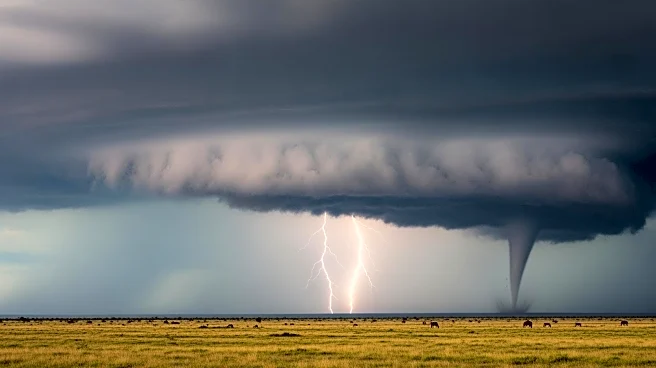What's Happening?
Weather forecasts indicate that conditions conducive to tornadoes and severe thunderstorms may persist in South Africa over the coming weeks. Recent incidents include tornadoes in Mpumalanga and Gauteng,
and heavy lightning strikes at God’s Window in Mpumalanga. Independent agricultural meteorologist Johan van den Berg notes that very windy conditions are increasing static electricity in the air, contributing to severe lightning, thunder, and tornado formation. The South African Weather Service confirmed a tornado in Germiston, while Vox Weather reported another between Belfast and Middelburg. Rainfall is expected to remain light in the winter rainfall region, with little chance of significant runoff to replenish dam levels. In the summer rainfall region, tropical moisture is anticipated to lead to isolated showers in late October.
Why It's Important?
The persistence of severe weather conditions poses significant risks to public safety and infrastructure in affected regions. Tornadoes and lightning can cause substantial damage to property and pose life-threatening risks to individuals caught in these events. The agricultural sector, particularly in regions dependent on rainfall, may face challenges due to the expected dry conditions in the winter rainfall region. The potential for heavy rainfall in the summer rainfall region could impact crop yields and water resource management. Understanding these weather patterns is crucial for preparing and mitigating the adverse effects on communities and industries.
What's Next?
Meteorologist Johan van den Berg suggests that stormy conditions will continue over central parts of South Africa and high-altitude regions. The winter rainfall region will remain dry as the rainy season ends, with potential for strong summer systems to develop later in the season. Heavy rainfall is anticipated over central and eastern parts of the summer rainfall region in October and November. A drier period may occur around February next year, contingent on the La Niña pattern's development and weakening.
Beyond the Headlines
The ongoing severe weather conditions highlight the importance of investing in weather prediction and disaster preparedness infrastructure. Enhancing early warning systems and community awareness can mitigate the impact of these natural events. Additionally, the agricultural sector may need to adapt to changing weather patterns by exploring drought-resistant crops and efficient water management practices.













